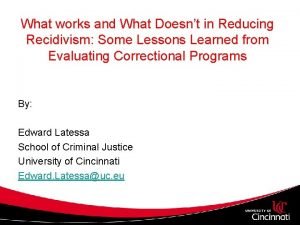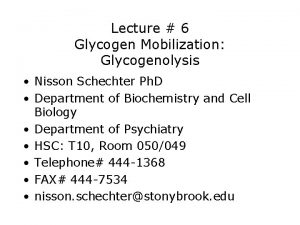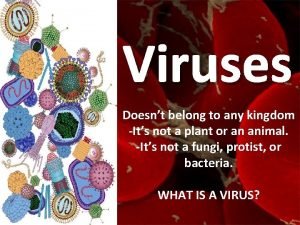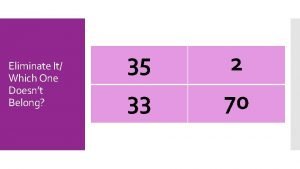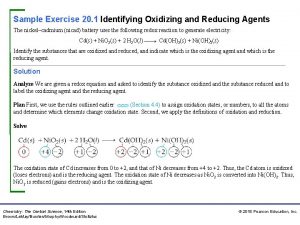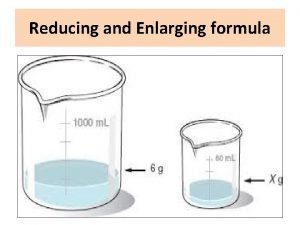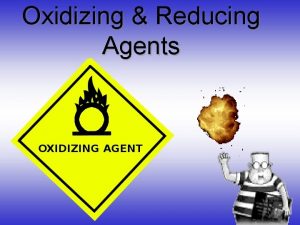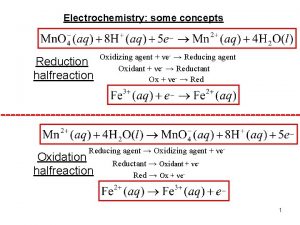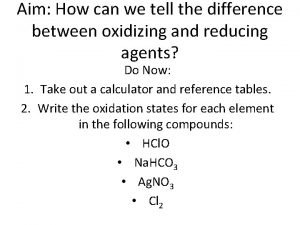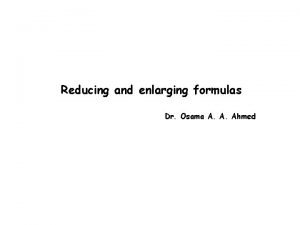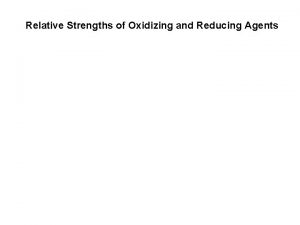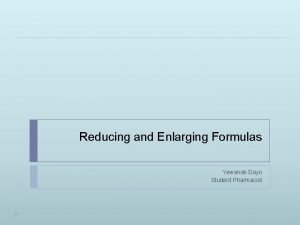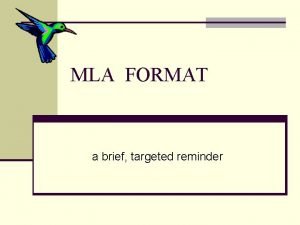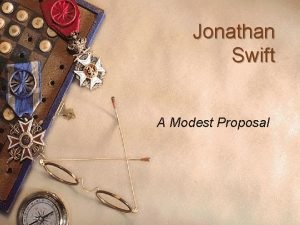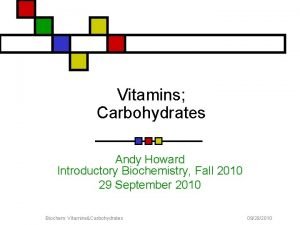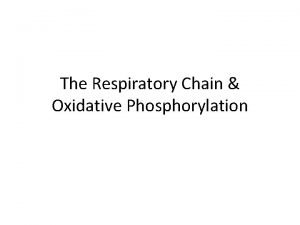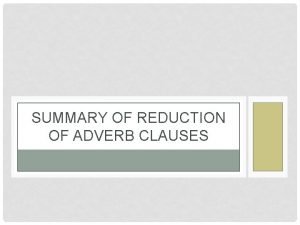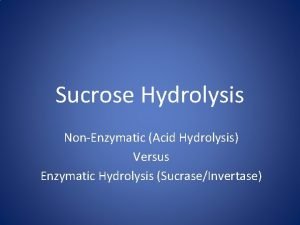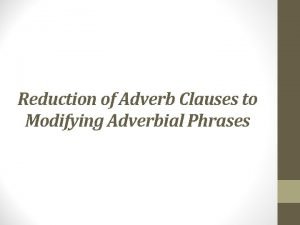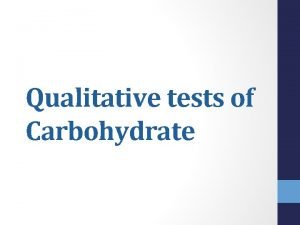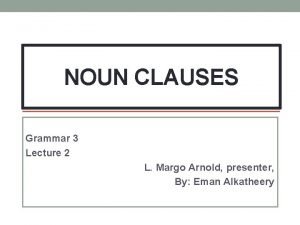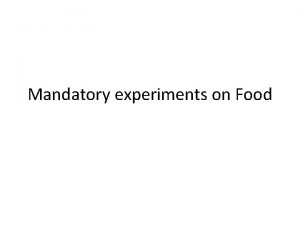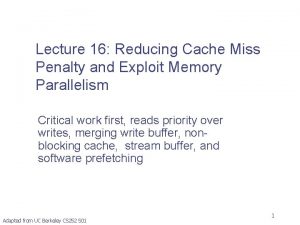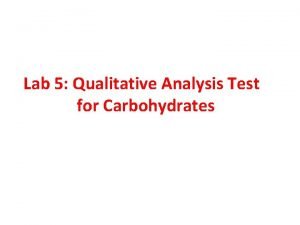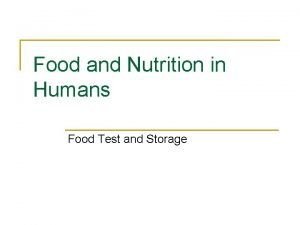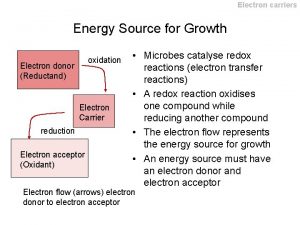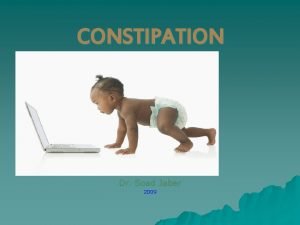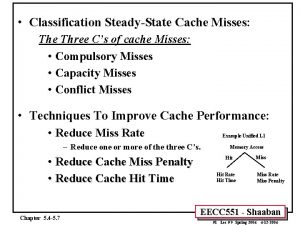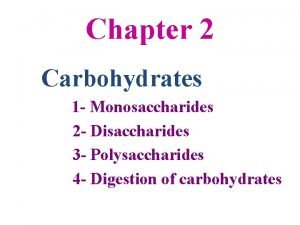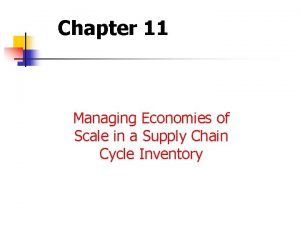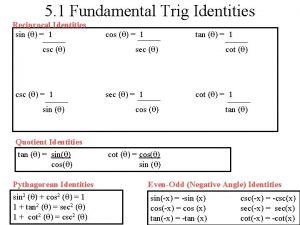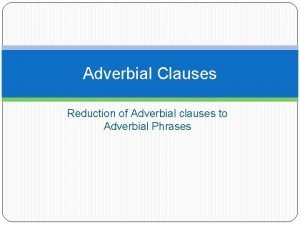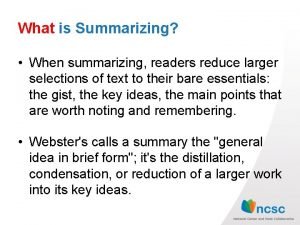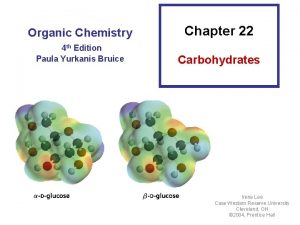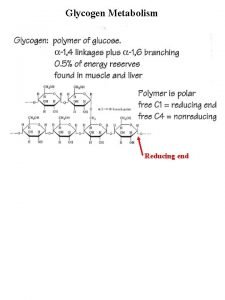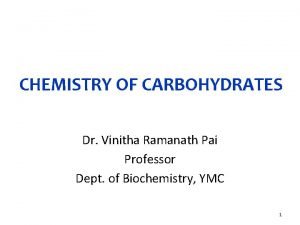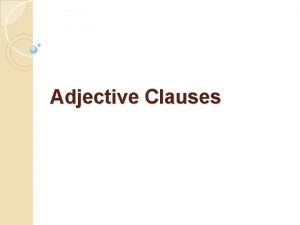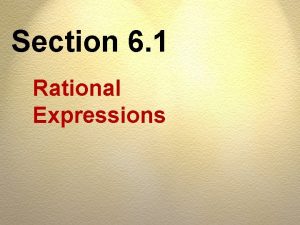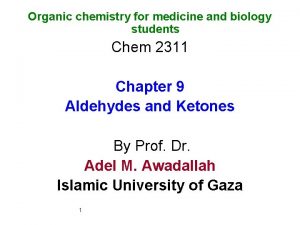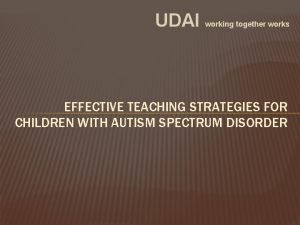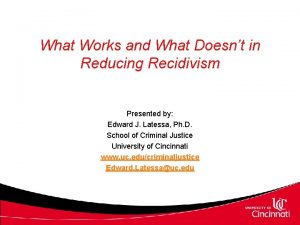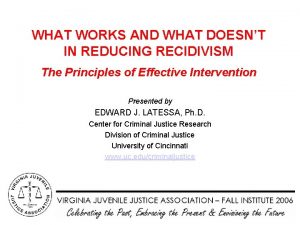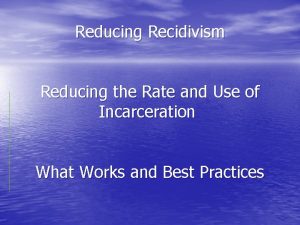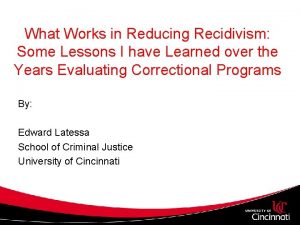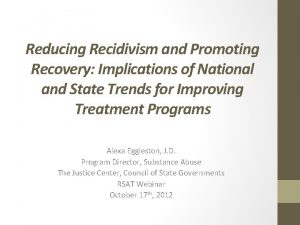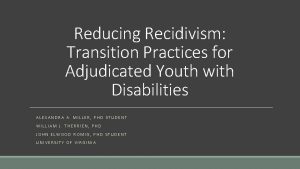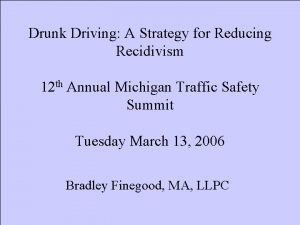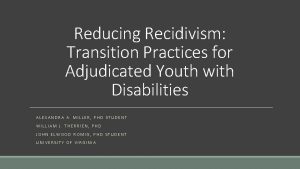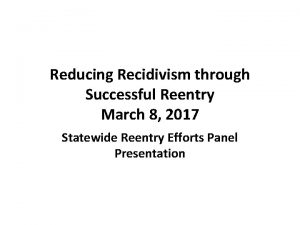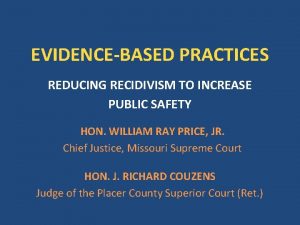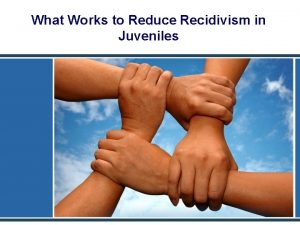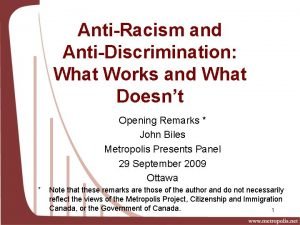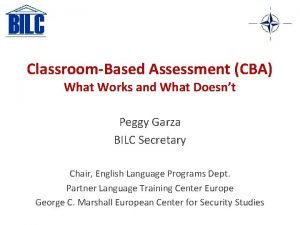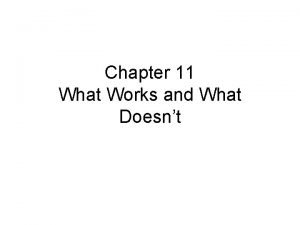What Works and What Doesnt in Reducing Recidivism















































































































- Slides: 111

What Works and What Doesn’t in Reducing Recidivism: How to Design more Effective Correctional Programs Presented by: Edward J. Latessa, Ph. D. School of Criminal Justice University of Cincinnati www. uc. edu/criminaljustice Edward. Latessa@uc. edu

Evidence Based – What does it mean? There are different forms of evidence: – The lowest form is anecdotal evidence; stories, opinions, testimonials, case studies, etc - but it often makes us feel good – The highest form is empirical evidence – research, data, results from controlled studies, etc. - but sometimes it doesn’t make us feel good

Evidence Based Practice is: 1. Easier to think of as Evidence Based Decision Making 2. Involves several steps and encourages the use of validated tools and treatments. 3. Not just about the tools you have but also how you use them

Evidence-Based Decision Making Requires 1. Assessment information - Valid and reliable offenders assessment process - Assessment of programs and practices 2. Relevant research - Consult research - Design and fund programs that are based on empirical evidence - Use existing resources (i. e. , Crimesolutions. gov) 3. Available programming - To reduce risk - Improve existing programs - Develop new programs

Evidence-Based Decision Making Requires: 4. Evaluation - Offenders - Quality assurance processes - Performance measures - Data 5. Professionalism and knowledge from staff - Understand EBP - Trained, coached, and skilled - Commitment

What does the Research tell us? There is often a Misapplication of Research: “XXX Study Says” - the problem is if you believe every study we wouldn’t eat anything (but we would drink a lot of red wine!) • Looking at one study can be a mistake • Need to examine a body of research • So, what does the body of knowledge about correctional interventions tell us?

FROM THE EARLIEST REVIEWS: • Not a single reviewer of studies of the effects of official punishment alone (custody, mandatory arrests, increased surveillance, etc. ) has found consistent evidence of reduced recidivism. • At least 40% and up to 60% of the studies of correctional treatment services reported reduced recidivism rates relative to various comparison conditions, in every published review.

Results from Meta Analysis: Criminal Sanctions versus Treatment Mean Phi Reduced Recidivism 0. 15 Increased Recidivism -0. 07 CS -. 07 (Number of Studies=30) Treatment. 15 (Number of Studies=124)

Criminal Sanctions vs. Treatment for Youthful Offenders 0. 14 Number of studies=54 Number of studies=175 0. 12 0. 1 0. 08 0. 06 0. 04 0. 02 0 -0. 02 -0. 04 Yes Criminal Sanctions -0. 02 Treatment 0. 13 Source: Dowden and Andrews (1999), What Works in Young Offender Treatment: A Meta Analysis. Forum on Correctional Research.

People Who Appear to be Resistant to Punishment • Psychopathic risk takers • Those under the influence of a substance • Those with a history of being punished

A Large Body of Research Has Indicated…. …. that correctional services and interventions can be effective in reducing recidivism for offenders, however, not all programs are equally effective • The most effective programs are based on some principles of effective interventions • Risk (Who) • Need (What) • Treatment (How) • Program Integrity (How Well)

Let’s Start with the Risk Principle Risk refers to risk of reoffending and not the seriousness of the offense.

Risk Principle As a general rule treatment effects are stronger if we target higher risk offenders, and harm can be done to low risk offenders

Percent with New Arrest Risk Level by Recidivism for the Community Supervision Sample Low 0 -14 Medium = 15 -23 High = 24 -33 Very High 34+

There are Three Elements to the Risk Principle 1. Target those offenders with higher probability of recidivism 2. Provide most intensive treatment to higher risk offenders 3. Intensive treatment for lower risk offender can increase recidivism

#1: Targeting Higher Risk Offenders • It is important to understand that even with EBP there will be failures. • Even if you reduce recidivism rates you will still have high percentage of failures

• • Example of Targeting Higher Risk Offenders If you have 100 High risk offenders about 60% will fail If you put them in well designed EBP for sufficient duration you may reduce failure rate to 40% If you have 100 low risk offenders about 10% will fail If you put them in same program failure rate will be 20%

Targeting Higher Risk Offenders continued: • In the end, who had the lower recidivism rate? • Mistake we make is comparing high risk to low risk rather than look for treatment effects

#2: Provide Most Intensive Interventions to Higher Risk Offenders

The question is: What does more “intensive” treatment mean in practice? • Most studies show that the longer someone is in treatment the great the effects, however: • Effects tend to diminish if treatment goes too long

Results from a 2010 Study (Latessa, Sperber, and Makarios) of 689 offenders • • 100 -bed secure residential facility for adult male offenders Cognitive-behavioral treatment modality Average 33 60% single, never married 43% less than high school education 80% moderate risk or higher 88% have probability of substance abuse per SASSI

2010 Dosage Study of 689 Offenders Sperber, , Latessa & Makarios (2013). Examining the Interaction between Level of Risk and Dosage of Treatment. Criminal Justice and Behavior, 40(3).

Findings • We saw large decreases in recidivism when dosage levels go from 100 to 200 hours for high risk offenders---81% to 57%. • The results are not as strong for moderate risk offenders

Results from 2014 Study • We expanded sample • Hours examined by increments of 50 • Looked at low/moderate, and high

2014 Dosage Study involving 903 offenders Makarios, Sperber, & Latessa (2014). Treatment Dosage and the Risk Principle: A Refinement and Extension. Journal of Offender Rehabilitation. 53: 334 -350.

Findings from Second Study • Relationship between dosage is not linear and moderated by risk • Largest changes in recidivism for low-moderate and moderate risk cases occurred when the dosage moved from less than 100 to 100 -149, and then back up when dosage increased (over 150 hours for lowmoderate, and over 300 for moderate). • For higher risk offenders largest reductions was when dosage went from 150 -199 to 200 -249. Reductions continued but at a lower rate.

Provide Most Intensive Interventions to Higher Risk Offenders • Higher risk offenders will require much higher dosage of treatment – Rule of thumb: 100 -150 hours for moderate risk – 200+ hours for high risk – 100 hours for high risk will have little effect – Does not include work/school and other activities that are not directly addressing criminogenic risk factors

Conclusions • Supports previous research including the risk principle • Indicates that we cannot have “one size” fits all programs

#3: Intensive Treatment for Low Risk Offenders will Often Increase Failure Rates • Low risk offenders will learn anti social behavior from higher risk • Disrupts pro-social networks • Increased reporting/surveillance leads to more violations/revocations

Study of Intensive Rehabilitation Supervision in Canada Recidivism Rates Bonta, J et al. , 2000. A Quasi-Experimental Evaluation of an Intensive Rehabilitation Supervision Program. , Vol. 27 No 3: 312 -329. Criminal Justice and Behavior

2002 STUDY OF COMMUNITY CORRECTIONAL PROGRAMS IN OHIO • Largest study of community based correctional treatment facilities ever done up to that time. • Total of 13, 221 offenders – 37 Halfway Houses and 15 Community Based Correctional Facilities (CBCFs) were included in the study. • Two-year follow-up conducted on all offenders • Recidivism measures included new arrests & incarceration in a state penal institution

Reduced Recidivism Increased Recidivism


2010 STUDY OF COMMUNITY CORRECTIONAL PROGRAMS IN OHIO • Over 20, 000 offenders – 44 Halfway Houses and 20 Community Based Correctional Facilities (CBCFs) were included in the study. • Two-year follow-up conducted on all offenders

-60 Harbor Light--D/A Comp. Drug MONDAY Oriana RIP Oriana CCTC West Central CATS male RTP TH Turtle Creek Cinti VOA SOT AH Alum Creek Harbor Light--Corr Alternatives Franklin STARK WORTH CTCC Canton NEOCAP Oriana TMRC TH Springrove Oriana Summit Pathfinder Oriana Cliff Skeen ALL CBCF FACILITIES EOCC Female ALL HWH FACILITIES Lorain-Medina Mahoning Oriana Crossweah River City STAR Talbert House CCC Booth H/Salv A CCA RTC II Cinti VOA D/A Comm Trans Ctr Crossroads Diversified Fresh Start SOS TH Pathways AH Dunning ARCA Oriana RCC Licking-Muskingum CATS female RTP Mansfield VOA SEPTA TH Cornerstone EOCC Male Lucas AH Price AH Veterans Dayton VOA Small Programs Toledo VOA Northwest CCC TH Beekman CATS male TC % Difference in Rate of New Felony Conviction Treatment Effects for Low Risk 60 50 40 30 20 10 0 -10 -20 -30 -40 -50

-60 AH Veterans TH Beekman MONDAY CTCC Canton TH Springrove Northwest CCC WORTH Diversified Oriana CCTC Oriana Summit Oriana Crossweah ARCA Booth H/Salv A CATS male RTP Crossroads Franklin Comm Trans Ctr STARK River City Talbert House CCC West Central EOCC Male ALL CBCF FACILITIES Comp. Drug AH Dunning Alternatives CCA RTC II Small Programs Harbor Light--D/A ALL HWH FACILITIES Oriana TMRC CATS male TC Fresh Start Dayton VOA NEOCAP Harbor Light--Corr Oriana RIP Licking-Muskingum Mahoning Cinti VOA D/A Oriana RCC STAR SOS Lucas CATS female RTP AH Price TH Turtle Creek Lorain-Medina Pathfinder Toledo VOA EOCC Female Oriana Cliff Skeen SEPTA AH Alum Creek Mansfield VOA TH Cornerstone CCA RTC I % Difference in Rate of New Felony Conviction Treatment Effects for High Risk 60 50 40 30 20 10 0 -10 -20 -30 -40 -50

Risk Level by New Commitment or New Adjudication: Results from 20013 Ohio Study of over 10, 000 Youth

Recidivism Rates by Total Months in Programs

Findings from Ohio Study • Recidivism rates for low risk youth served in the community were 2 to 4 times lower than those served in Residential or Institutional facilities • We also found that placing low risk youth in Substance Abuse programs significantly increased their recidivism rates, as did placement in Day Reporting, however the N was extremely small. • High risk youth were more successful when they received a higher dosage of treatment (programming for 13 months or more). • Lower and moderate risk youth did better with lower dosage programs.

To understand the Need Principle we need to review the body of knowledge related to risk factors What are the risk factors correlated with criminal conduct?

Major Set of Risk/Need Factors 1. Antisocial/procriminal attitudes, values, beliefs and cognitive-emotional states

Cognitive Emotional States • • Rage Anger Defiance Criminal Identity

Identifying Procriminal Attitudes, Values & Beliefs Procriminal sentiments are what people think, not how people think; they comprise the content of thought, not the skills of thinking. What to listen for: • Negative expression about the law • Negative expression about conventional institutions, values, rules, & procedures; including authority • Negative expressions about self-management of behavior; including problem solving ability • Negative attitudes toward self and one’s ability to achieve through conventional means • Lack of empathy and sensitivity toward others

Neutralization & Minimizations Offenders often neutralize their behavior. Neutralizations are a set of verbalizations which function to say that in particular situations, it is “OK” to violate the law Neutralization Techniques include: • Denial of Responsibility: Criminal acts are due to factors beyond the control of the individual, thus, the individual is guilt free to act. • Denial of Injury: Admits responsibility for the act, but minimizes the extent of harm or denies any harm • Denial of the Victim: Reverses the role of offender & victim & blames the victim • “System Bashing”: Those who disapprove of the offender’s acts are defined as immoral, hypocritical, or criminal themselves. • Appeal to Higher Loyalties: “Live by a different code” – the demands of larger society are sacrificed for the demands of more immediate loyalties. (Sykes and Maltz, 1957)

Major set Risk/needs continued: 2. Procriminal associates and isolation from prosocial others

Major set Risk/Needs continued: 3. Temperamental & anti social personality pattern conducive to criminal activity including: – – – – – Weak Socialization Impulsivity Adventurous Pleasure seeking Restless Aggressive Egocentrism Below Average Verbal intelligence A Taste For Risk Weak Problem-Solving/lack of Coping & Self-Regulation Skills

Major set of Risk/Need factors continued: 4. A history of antisocial behavior: – Evident from a young age – In a variety of settings – Involving a number and variety of different acts

Major set of Risk/Needs Continued: 5. Family factors that include criminality and a variety of psychological problems in the family of origin including: – Low levels of affection, caring and cohesiveness – Poor parental supervision and discipline practices – Out right neglect and abuse

Major set of Risk/Needs continued: 6. Low levels of personal educational, vocational or financial achievement

Leisure and/or recreation 7. Low levels of involvement in prosocial leisure activities – Allows for interaction with antisocial peers – Allows for offenders to have idle time – Offenders replace prosocial behavior with antisocial behavior

Substance Abuse 8. Abuse of alcohol and/or drugs –It is illegal itself (drugs) –Engages with antisocial others –Impacts social skills

Major Risk and/or Need Factor and Promising Intermediate Targets for Reduced Recidivism Factor Risk Dynamic Need History of Antisocial Behavior Early & continued involvement in a number antisocial acts Build noncriminal alternative behaviors in risky situations Antisocial personality Adventurous, pleasure Build problem-solving, selfseeking, weak self management, anger mgt & control, restlessly aggressive coping skills Antisocial cognition Attitudes, values, beliefs & rationalizations supportive of crime, cognitive emotional states of anger, resentment, & defiance Reduce antisocial cognition, recognize risky thinking & feelings, build up alternative less risky thinking & feelings Adopt a reform and/or anticriminal identity Antisocial associates Close association with criminals & relative isolation from prosocial people Reduce association w/ criminals, enhance association w/ prosocial people Adopted from Andrews, D. A. et al, (2006). The Recent Past and Near Future of Risk and/or Need Assessment. Crime and Delinquency, 52 (1).

Major Risk and/or Need Factor and Promising Intermediate Targets for Reduced Recidivism Factor Risk Dynamic Need Family and/or marital Two key elements are nurturance and/or caring better monitoring and/or supervision Reduce conflict, build positive relationships, communication, enhance monitoring & supervision School and/or work Low levels of performance Enhance performance, & satisfaction rewards, & satisfaction Leisure and/or recreation Low levels of involvement Enhance involvement & satisfaction in anti& satisfaction in prosocial criminal leisure activities Substance Abuse of alcohol and/or drugs Reduce SA, reduce the personal & interpersonal supports for SA behavior, enhance alternatives to SA Adopted from Andrews, D. A. et al, (2006). The Recent Past and Near Future of Risk and/or Need Assessment. Crime and Delinquency, 52 (1).

Recent study by Bucklen and Zajac of parole violators in Pennsylvania found a number of criminogenic factors related to failure* *Conducted by Pennsylvania Dept. of Corrections

Pennsylvania Parole Study Social Network and Living Arrangements Violators Were: • More likely to hang around with individuals with criminal backgrounds • Less likely to live with a spouse • Less likely to be in a stable supportive relationship • Less likely to identify someone in their life who served in a mentoring capacity

Pennsylvania Parole Study Employment & Financial Situation Violators were: • Only slightly more likely to report having difficulty getting a job • Less likely to have job stability • Less likely to be satisfied with employment • Less likely to take low end jobs and work up • More likely to have negative attitudes toward employment & unrealistic job expectations • Less likely to have a bank account • More likely to report that they were “barely making it” (yet success group reported over double median debt)

Pennsylvania Parole Study Alcohol or Drug Use Violators were: • More likely to report use of alcohol or drugs while on parole (but no difference in prior assessment of dependency problem) • Poor management of stress was a primary contributing factor to relapse

Pennsylvania Parole Study Life on Parole - Violators were: • • • Had poor problem solving or coping skills Did not anticipate long term consequences of behavior Failed to utilize resources to help themselves Acted impulsively to immediate situations Felt they were not in control More likely to maintain anti-social attitudes Viewed violations as an acceptable option to situation Maintained general lack of empathy Shifted blame or denied responsibility Had unrealistic expectations about what life would be like outside of prison

Pennsylvania Parole Violator Study: • Successes and failures did not differ in difficulty in finding a place to live after release • Successes & failures equally likely to report eventually obtaining a job

Need Principle By assessing and targeting criminogenic needs for change, agencies can reduce the probability of recidivism Criminogenic Non-Criminogenic • • • Anti social attitudes Anti social friends Substance abuse Lack of empathy Impulsive behavior Anxiety Low self esteem Creative abilities Medical needs Physical conditioning

Targeting Criminogenic Need: Results from Meta. Analyses Reduction in Recidivism Increase in Recidivism Source: Gendreau, P. , French, S. A. , and A. Taylor (2002). What Works (What Doesn’t Work) Revised 2002. Invited Submission to the International Community Corrections Association Monograph Series Project

Criminal Thinking and Mental Illness* Morgan, Fisher, Duan, Mandracchia, and Murray (2010) studied 414 adult offenders with mental illness (265 males, 149 females) and found: • 66% had belief systems supportive of criminal life style (based on Psychological Inventory of Criminal Thinking Scale (PICTS) • When compare to other offender samples, male offenders with MI scores similar or higher than non-mentally disordered offenders. • On Criminal Sentiments Scale-Revised, 85% of men and 72% of women with MI had antisocial attitudes, values and beliefs – which was higher than incarcerated sample without MI. See: Prevalence of Criminal Thinking among State Prison Inmates with Serious Mental Illness. Law and Human Behavior 34: 324 -336, and Center for Behavioral Health Services Criminal Justice Research Policy Brief, April 2010. Rutgers University.

Conclusion • Criminal Thinking styles differentiate people who commit crimes from those who do not independent of mental illness • Incarcerated persons with mental illness are often mentally ill and criminal • Needs to be treated as co-occurring problems


Assessment is the engine that drives effective correctional programs • Need to meet the risk and need principle • Reduces bias • Aids decision making • Allows you to target dynamic risk factors and measure change

One New Non-Proprietary System is the ORAS The Ohio Risk Assessment System (ORAS) consists of 6 basic tools: 1. Pre-Trial Tool (ORAS-PAT) 2. Misdemeanor Assessment Tool (ORAS-MAT) 3. Community Supervision Assessment Tool (ORAS-CST) 4. Prison Intake Screening Tool (ORAS-PST) 5. Prison Intake Tool (ORAS-PIT) 6. Reentry Tool (ORAS-RT)

ORAS-CST Intake Assessment

To Understand Assessment it is Important to Understand Types of Risk Factors

Dynamic and Static Factors • Static Factors are those factors that are related to risk and do not change. Some examples might be number of prior offenses, whether an offender has ever had a drug/alcohol problem. • Dynamic factors relate to risk and can change. Some examples are whether an offender is currently unemployed or currently has a drug/alcohol problem.

According to the American Heart Association, there a number of risk factors that increase your chances of a first heart attack ü Family history of heart attacks ü Gender (males) ü Age (over 50) ü Inactive lifestyle ü Over weight ü High blood pressure ü Smoking ü High Cholesterol level

There are two types of dynamic risk factors • Acute – Can change quickly • Stable – Take longer to change

Treatment Principle The most effective interventions are behavioral: • Focus on current factors that influence behavior • Action oriented • Staff follow “core correctional practices”

Results from Meta Analysis: Behavioral vs. Non. Behavioral Reduced Recidivism Andrews, D. A. 1994. An Overview of Treatment Effectiveness. Research and Clinical Principles, Department of Psychology, Carleton University. The N refers to the number of studies.

Type of Treatment and Effect Sizes for Youthful Offenders 0. 25 0. 2 0. 15 Reductions in Recidivism 0. 1 0. 05 0 Non-Behavioral Effect Size 0. 04 Behavioral 0. 24 Source: Dowden and Andrews (1999), What Works in Young Offender Treatment: A Meta Analysis. Forum on Correctional Research.

Core Correctional Practices 1. 2. 3. 4. 5. 6. 7. 8. Effective Reinforcement Effective Disapproval Effective Use of Authority Quality Interpersonal Relationships Cognitive Restructuring Anti-criminal Modeling Structured Learning/Skill Building Problem Solving Techniques

Core Correctional Practices and Recidivism Effect Size Gendreau (2003). Invited Address. APA Annual Conference. Toronto.

Ratio of Rewards to Punishments and Probability of Success on Intensive Supervision 90% Probability of ISP Success 80% 70% 60% 50% 40% 30% 20% 10% 0% 1: 10 1: 08 1: 06 1: 04 1: 02 2: 01 4: 01 6: 01 Ratio of Rewards to Punishments 8: 01 10: 01 Widahl, E. J. , Garland, B. Culhane, S. E. , and Mc. Carty, W. P. (2011). Utilizing Behavioral Interventions to Improve Supervision Outcomes in Community-Based Corrections. Criminal Justice and Behavior, 38 (4).

List of Rewards and Sanctions • • • Verbal reprimand Written assignment Modify curfew hours Community service hours Restrict visitation Program extension or regression Electronic Monitoring Inpatient or outpatient txt Detention time Rewards • Verbal praise and reinforcement • Remove from EM • Level advancement • Increased personal time • Approved special activity • Fees reduced • Approve of extend special visitation Widahl, E. J. , Garland, B. Culhane, S. E. , and Mc. Carty, W. P. (2011). Utilizing Behavioral Interventions to Improve Supervision Outcomes in Community-Based Corrections. Criminal Justice and Behavior, 38 (4).

Sanction Type by Offender Compliance Wadahl, Boman and Garland (2015) examined 283 offenders on ISP and looked at the effectiveness of jail time versus community-based sanctions. Widahl, E. J. , Boman, J. H. and Garland, B. E. . (2015). Responding to Probation and Parole Violations: Are Jail Sanctions more Effective than Community-based Graduated Sanctions? Journal of Criminal Justice, 43: 243 -250.

List of Sanctions Verbal reprimand Written assignment Modify curfew hours Community service hours Restrict visitation Program extension or regression Electronic Monitoring Inpatient or outpatient txt County jail time Widahl, E. J. , Boman, J. H. and Garland, B. E. . (2015). Responding to Probation and Parole Violations: Are Jail Sanctions more Effective than Community-based Graduated Sanctions? Journal of Criminal Justice, 43: 243 -250.

They found Jail Time: • Was not related to number of days until the next violation • Did not increase or decrease the number of subsequent violations • Receiving jail time as a sanction as opposed to a community-based sanction did not influence successful completion of supervision

Most Effective Behavioral Models • Structured social learning where new skills and behaviors are modeled • Family based approaches that train family on appropriate techniques • Cognitive behavioral approaches that target criminogenic risk factors

Social Learning Refers to several processes through which individuals acquire attitudes, behavior, or knowledge from the persons around them. Both modeling and instrumental conditioning appear to play a role in such learning

Some Family Based Interventions • Designed to train family on behavioral approaches – Functional Family Therapy – Multi-Systemic Therapy – Teaching Family Model – Strengthening Families Program – Common Sense Parenting – Parenting Wisely

Effectiveness of Family Based Intervention: Results from Meta Analysis • 38 primary studies with 53 effect tests • Average reduction in recidivism= 21% However, much variability was present (-0. 17 - +0. 83) Dowden & Andrews, 2003

Mean Effect Sizes: Whether or not the family intervention adheres to the principles

The Four Principles of Cognitive Intervention 1. Thinking affects behavior 2. Antisocial, distorted, unproductive irrational thinking can lead to antisocial and unproductive behavior 3. Thinking can be influenced 4. We can change how we feel and behave by changing what we think

Recent Meta-Analysis of Cognitive Behavioral Treatment for Offenders by Landenberger & Lipsey (2005)* • Reviewed 58 studies: 19 random samples 23 matched samples 16 convenience samples • Found that on average CBT reduced recidivism by 25%, but the most effective configurations found more than 50% reductions

Significant Findings (effects were stronger if): • • Sessions per week (2 or more) - RISK Implementation monitored - FIDELITY Staff trained on CBT - FIDELITY Higher proportion of treatment completers RESPONSIVITY • Higher risk offenders - RISK • Higher if CBT is combined with other services NEED

Some Examples of Cognitive Behavioral Correctional Curriculums • Aggression Replacement Training (ART) • Criminal Conduct and Substance Abuse Treatment • Thinking for a Change (nonproprietary) • UC's Cognitive Behavioral Interventions for Offenders Seeking Employment (nonproprietary – pilot underway) • UC’s Cognitive Behavioral Interventions for Substance Abuse (non-proprietary) • Moving On (Female Offenders) • UC’s Cognitive Behavioral Treatment for Sex Offenders (non-proprietary) • UC's Cognitive Behavioral Interventions for Offenders - A comprehensive curriculum (nonproprietary – pilot underway). Also adaptable for MDOs.

Reducing Prison & Jail Misconducts • Findings from a 2006 meta analysis of 68 studies involving 21, 467 offenders • Outcomes included violent misconduct, nonviolent misconduct, and institutional adjustment • Sample included 73% male, 8% female & 19% coed. • Included both adult and juvenile samples





We are currently training on a new model of PO and Case Manger interaction Effective Practices in Correctional Supervision (EPICS) 96

Traditional Officer-Offender Interactions are often not Effective because: q They are too brief to have an impact q Conversations focus almost exclusively on monitoring compliance conditions (and therefore emphasize external controls on behavior rather than developing an internal rationale for pro-social behavior) q Relationship is often more confrontational and authoritarian in nature than helpful q What is targeted is not always based on assessment q More areas discussed=less effective 97

Structure of EPICS Meeting SESSION OVERVIEW • Each session should be structured in the following way: 1. Check-In 2. Review 3. Intervention 4. Homework 98

Rationale for EPICS Preliminary Data from Canada: q. Trained officers had 12% higher retention rates in comparison with untrained officers at six months. q. Also found reductions in recidivism 99

Two year Recidivism Results from Canadian Study Bont, et al, (2010) The Strategic Training Initiative in Community Suopervision: Risk-Need-Responsivity in the Real World. Public Safety Canada.

Findings from Federal Probation Sample Robinson, Vanbenschoten, Alexander, and Lowenkamp, Forthcoming, Federal Probation, Sept. 2011.

Recidivism Results from Ohio Study looking at Fidelity and High Risk Offenders (adult and juvenile Latessa, E. , Smith, P. , Schweitzer, m. , and Labrecque, R. (2013). Evaluation of the Effective Practices in Community Supervision Model (EPICS) in Ohio. School of Criminal Justice, University of Cincinnati.

EPICS • Helps bring together all of your EBP efforts: – – – – Risk assessment and priority on higher risk offenders Focus on criminogenic needs Takes motivational interviewing to the next level Supports programs and services Helps PO become a more effective agent of change Increases compliance Reduces recidivism

We are Currently Piloting a New Version: Effective Practices for Community Support (EPICS for Influencers) • Pilot Sites include: – LA County Jail Reentry Program – Hamilton County (Cincinnati) Reentry Coalition – Portsmouth, OH Juvenile Truancy and Mentoring Program

These approaches help us…. • Structure our interventions • Teach and model new skills • Allow offender to practice with graduated difficulty • Reinforce the behavior

What Doesn’t Work with Offenders?

Lakota tribal wisdom says that when you discover you are riding a dead horse, the best strategy is to dismount. However, in corrections, and in other affairs, we often try other strategies, including the following: • • • Buy a stronger whip. Change riders Say things like “This is the way we always have ridden this horse. ” Appoint a committee to study the horse. Arrange to visit other sites to see how they ride dead horses. Create a training session to increase our riding ability. Harness several dead horses together for increased speed. Declare that “No horse is too dead to beat. ” Provide additional funding to increase the horse’s performance. Declare the horse is “better, faster, and cheaper” dead. Study alternative uses for dead horses. Promote the dead horse to a supervisory position.

Ineffective Approaches with Offenders • Programs that cannot maintain fidelity • Programs that target non-criminogenic needs • Drug prevention classes focused on fear and other emotional appeals • Shaming offenders • Drug education programs • Non-directive, client centered approaches • Bibliotherapy • Talking cures • Self-Help programs • Vague unstructured rehabilitation programs • “Punishing smarter” (boot camps, scared straight, etc. )

Fidelity Principle Making sure the program is delivered as designed and with integrity: • Ensure staff are modeling appropriate behavior, are qualified, well trained, well supervision, etc. • Make sure barriers are addressed but target criminogenic needs • Make sure appropriate dosage of treatment is provided • Monitor delivery of programs & activities, etc. • Reassess offenders in meeting target behaviors


Some Lessons Learned from the Research Ø Who you put in a program is important – pay attention to risk Ø What you target is important – pay attention to criminogenic needs Ø How you target offender for change is important – use behavioral approaches Ø Program Integrity makes a difference - Service delivery, training/supervision of staff, support for program, QA, evaluation, etc.
 What works and doesn't in reducing recidivism download
What works and doesn't in reducing recidivism download Recidive
Recidive Fates of glucose
Fates of glucose Maltosazone shape
Maltosazone shape What is reducing sugar
What is reducing sugar What goes up and doesnt come down
What goes up and doesnt come down Reducing vs non reducing sugar
Reducing vs non reducing sugar The catcher in the rye jane gallagher
The catcher in the rye jane gallagher Doesnt really matter
Doesnt really matter What kingdom do viruses belong to
What kingdom do viruses belong to Youlust porn
Youlust porn Gfletchy 3 act tasks
Gfletchy 3 act tasks King hector doesn't drink chocolate milk
King hector doesn't drink chocolate milk Dont tense
Dont tense Stuart gitlow
Stuart gitlow Safety at street works and road works a code of practice
Safety at street works and road works a code of practice How to identify the oxidizing agent
How to identify the oxidizing agent 5 formula
5 formula Factor method in reducing and enlarging formula
Factor method in reducing and enlarging formula Strong reduction agent
Strong reduction agent Reduction potential table
Reduction potential table Example of bulk-gaining industry
Example of bulk-gaining industry Differentiate between oxidizing and reducing agents
Differentiate between oxidizing and reducing agents Enlarging and reducing formula
Enlarging and reducing formula Relative strengths of oxidizing and reducing agents
Relative strengths of oxidizing and reducing agents Reducing and enlarging formulas pdf
Reducing and enlarging formulas pdf Public works and infrastructure logo
Public works and infrastructure logo How to cite romeo and juliet mla
How to cite romeo and juliet mla Ministry of works, transport and communications
Ministry of works, transport and communications Inner party 1984
Inner party 1984 Ernest hemingway prose
Ernest hemingway prose William blake life and works
William blake life and works Used in both the folk and classical court music of korea
Used in both the folk and classical court music of korea City of houston idm
City of houston idm Public works north west
Public works north west Ministry of public works and transport cambodia
Ministry of public works and transport cambodia John milton born
John milton born Explanation purpose
Explanation purpose What works student retention and success
What works student retention and success Ministry of regional development and public works
Ministry of regional development and public works Ministry of regional development and public works
Ministry of regional development and public works A modest proposal hyperbole
A modest proposal hyperbole Industrial location model
Industrial location model Reducing equivalents
Reducing equivalents What is the reducing end of a sugar
What is the reducing end of a sugar Reducing equivalents
Reducing equivalents Reduced dependent clause
Reduced dependent clause Reducing sugars examples
Reducing sugars examples Cos 2x identities
Cos 2x identities Adverbial clause definition
Adverbial clause definition Reducing rational expressions to lowest terms
Reducing rational expressions to lowest terms Carbohydrates test
Carbohydrates test Powerful oxidising agent
Powerful oxidising agent Reduction reaction
Reduction reaction Reducing noun clauses
Reducing noun clauses Is ethanol bulk gaining or reducing
Is ethanol bulk gaining or reducing Food test colour changes
Food test colour changes Techniques for reducing cache misses
Techniques for reducing cache misses Critical word first and early restart
Critical word first and early restart Fructose is non reducing sugar
Fructose is non reducing sugar Food test for reducing sugar
Food test for reducing sugar Food test for reducing sugar
Food test for reducing sugar Electron carriers
Electron carriers Encorporesis
Encorporesis Map reducing in cloud computing
Map reducing in cloud computing Techniques for reducing cache misses
Techniques for reducing cache misses Oil rig oxidation
Oil rig oxidation Reasons for reducing project duration
Reasons for reducing project duration Chapter 20 oxidation-reduction reactions answer key
Chapter 20 oxidation-reduction reactions answer key Are ketoses reducing sugars
Are ketoses reducing sugars Managing economies of scale in a supply chain
Managing economies of scale in a supply chain Examples of bulk reducing industry
Examples of bulk reducing industry Csc trig
Csc trig How can tourism reduce the development gap in jamaica
How can tourism reduce the development gap in jamaica Reducing ratios answer key
Reducing ratios answer key Reducing balance method
Reducing balance method How are disposals of plant assets accounted for
How are disposals of plant assets accounted for Iso standard drawing scales
Iso standard drawing scales Adverb clause
Adverb clause Summarizing
Summarizing Reduction of adjective clause
Reduction of adjective clause Panaldin
Panaldin Sucrose is reducing sugar
Sucrose is reducing sugar Reducing project duration
Reducing project duration Sulfate reducing bacteria
Sulfate reducing bacteria Reducing ends in glycogen
Reducing ends in glycogen Fecal fat qualitative
Fecal fat qualitative Sugar
Sugar Hemiacetal group in maltose
Hemiacetal group in maltose Using expressions of quantity in adjective clauses
Using expressions of quantity in adjective clauses Reducing rational expressions to lowest terms
Reducing rational expressions to lowest terms Reducing agent
Reducing agent Gas welding flames
Gas welding flames Reducing er diagram to tables
Reducing er diagram to tables What is a work cited page
What is a work cited page Purpose of citation
Purpose of citation Book with two author example
Book with two author example How to write citation with 3 authors
How to write citation with 3 authors How conduction works
How conduction works Purdue owl mla
Purdue owl mla Bibliography vs works cited
Bibliography vs works cited How to do a work cited
How to do a work cited Wvu registrar office
Wvu registrar office Complete the table with mahbubs information
Complete the table with mahbubs information Udai working together works
Udai working together works Panasonic electric works italia
Panasonic electric works italia Turnitin products
Turnitin products Turbine engine animation
Turbine engine animation P type bjt
P type bjt Buffalo state college degree works
Buffalo state college degree works How analog video works
How analog video works How analog video works
How analog video works
